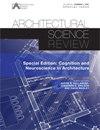在尼日利亚埃努古大都市炎热潮湿的热带环境中,暴露于湿气对立面饰面生物降解的影响
IF 1.8
3区 艺术学
0 ARCHITECTURE
引用次数: 1
摘要
这项研究调查了在尼日利亚东南部埃努古大都市的湿热热带地区,暴露在湿气中如何影响外墙饰面的生物退化。物理观测和实验研究策略被用于收集研究区域383栋建筑的数据。使用描述性和逻辑回归分析对数据进行分析。结果显示,53.5%的住宅建筑和88.5%的水泥外墙饰面,其中66.8%的建筑外墙饰面暴露在湿气中。此外,64%的外墙饰面,主要是胶结材料和油漆,被微生物定植,最常见的微生物是真菌。我们发现,暴露在潮湿环境中的外墙饰面发生生物降解的可能性要高出四倍。该研究得出的结论是,为了遏制外墙饰面的微生物定植及其随之而来的不利影响,建筑师应采取设计策略,最大限度地减少外墙饰面暴露在湿气中的程度。本文章由计算机程序翻译,如有差异,请以英文原文为准。
Effects of exposure to moisture on biodeterioration of facade finishes in the hot-humid tropical environment of Enugu metropolis, Nigeria
This research investigated how exposure to moisture influences the biodeterioration of facade finishes in the hot-humid tropics of Enugu metropolis, Southeast Nigeria. Physical observations and experimental research strategy were used to collect data from 383 buildings in the study area. The data were analysed using descriptive and logistic regression analyses. The results showed that 53.5% were residential buildings and 88.5% had cementitious façade finishes with 66.8% of them having their façade finishes exposed to moisture. Further, 64% of the facade finishes, mainly of cementitious materials and paints were colonized by microorganisms with the most common microbes being fungi. Façade finishes exposed to moisture we found to be four times more likely to experience biodeterioration. The study concludes that in order to curb microbial colonization of façade finishes and the attendant adverse effects, architects should engage in design strategies that can minimize the level of exposure of façade finishes to moisture.
求助全文
通过发布文献求助,成功后即可免费获取论文全文。
去求助
来源期刊

Architectural Science Review
ARCHITECTURE-
CiteScore
4.80
自引率
8.70%
发文量
34
期刊介绍:
Founded at the University of Sydney in 1958 by Professor Henry Cowan to promote continued professional development, Architectural Science Review presents a balanced collection of papers on a wide range of topics. From its first issue over 50 years ago the journal documents the profession’s interest in environmental issues, covering topics such as thermal comfort, lighting, and sustainable architecture, contributing to this extensive field of knowledge by seeking papers from a broad geographical area. The journal is supported by an international editorial advisory board of the leading international academics and its reputation has increased globally with individual and institutional subscribers and contributors from around the world. As a result, Architectural Science Review continues to be recognised as not only one of the first, but the leading journal devoted to architectural science, technology and the built environment. Architectural Science Review publishes original research papers, shorter research notes, and abstracts of PhD dissertations and theses in all areas of architectural science including: -building science and technology -environmental sustainability -structures and materials -audio and acoustics -illumination -thermal systems -building physics -building services -building climatology -building economics -ergonomics -history and theory of architectural science -the social sciences of architecture
 求助内容:
求助内容: 应助结果提醒方式:
应助结果提醒方式:


